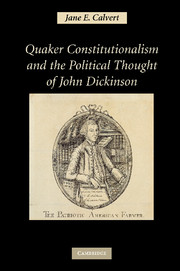Book contents
- Frontmatter
- Contents
- Acknowledgments
- Abbreviations
- Introduction
- I QUAKER CONSTITUTIONALISM IN THEORY AND PRACTICE, C. 1652–1763
- II THE POLITICAL QUAKERISM OF JOHN DICKINSON, 1763–1789
- 6 Turbulent but Pacific: “Dickinsonian Politics” in the American Revolution
- 7 “The Worthy Against the Licentious”: The Critical Period in Pennsylvania
- 8 “The Political Rock of Our Salvation”: The U.S. Constitution According to John Dickinson
- Epilogue: The Persistence of Quaker Constitutionalism, 1789–1963
- Bibliography
- Index
- References
8 - “The Political Rock of Our Salvation”: The U.S. Constitution According to John Dickinson
Published online by Cambridge University Press: 27 July 2009
- Frontmatter
- Contents
- Acknowledgments
- Abbreviations
- Introduction
- I QUAKER CONSTITUTIONALISM IN THEORY AND PRACTICE, C. 1652–1763
- II THE POLITICAL QUAKERISM OF JOHN DICKINSON, 1763–1789
- 6 Turbulent but Pacific: “Dickinsonian Politics” in the American Revolution
- 7 “The Worthy Against the Licentious”: The Critical Period in Pennsylvania
- 8 “The Political Rock of Our Salvation”: The U.S. Constitution According to John Dickinson
- Epilogue: The Persistence of Quaker Constitutionalism, 1789–1963
- Bibliography
- Index
- References
Summary
Historians have not considered the Quaker presence at the creation of the U.S. Constitution, although there is good reason for doing so. As we have seen, Quakers were a powerful force in Pennsylvania, and they disseminated their theologico-political thought aggressively and, in some regards, successfully. Although at the Revolution, the Society of Friends as a body had withdrawn from formal politics, they remained active on a grassroots level, and they retained a significant measure of political influence. In debates over the ratification of the Constitution, delegates to the Convention speculated on the position of Friends, their views on such specifics as liberty of conscience, slavery, and religious tests for office; their past influence in Pennsylvania; and their future influence on the state and the federal governments. Moreover, because of their strong presence as the governors of provincial Pennsylvania, there remained a residual influence even at the highest level of government.
As far as religious influences on the Constitution are concerned, historians have given most of their attention to reformed Calvinism. But there is more evidence of a direct, albeit limited Quaker influence on this important moment in history than there is of a Puritan, deistic, or Evangelical one. John Dickinson, with his strengthening Quaker convictions, was among the most important participants at the Convention. He was part of what Jack Rakove calls the “crucial nucleus” of Framers. Forrest McDonald suggests that Dickinson's thought “may well be regarded as [a model] for the American political tradition.
- Type
- Chapter
- Information
- Publisher: Cambridge University PressPrint publication year: 2008



